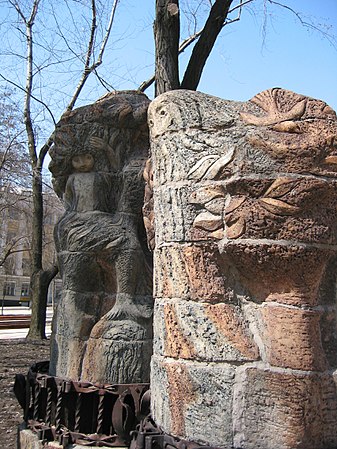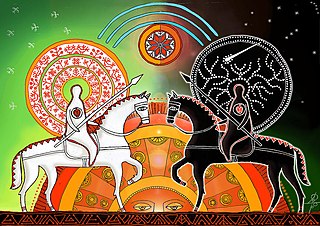
Chernobog and Belobog are an alleged pair of Polabian deities. Chernobog appears in Helmold's Chronicle as a god of misfortune worshipped by the Wagri and Obodrites, while Belobog is not mentioned – he was reconstructed in opposition to Chernobog. Both gods also appear in later sources, but they are not considered reliable. Researchers do not agree on the status of Chernobog and Belobog: many scholars recognize the authenticity of these theonyms and explain them, for example, as gods of good and evil; on the other hand, many scholars believe that they are pseudo-deities, and Chernobog may have originally meant "bad fate", and later associated with the Christian devil.

Slavic mythology or Slavic paganism is the religious beliefs, myths, and ritual practices of the Slavs before Christianisation, which occurred at various stages between the 8th and the 13th century. The South Slavs, who likely settled in the Balkan Peninsula during the 6th–7th centuries AD, bordering with the Byzantine Empire to the south, came under the sphere of influence of Eastern Christianity, beginning with the creation of writing systems for Slavic languages in 855 by the brothers Saints Cyril and Methodius and the adoption of Christianity in Bulgaria in 864 and 863 in Great Moravia. The East Slavs followed with the official adoption in 988 by Vladimir the Great of Kievan Rus'.

Devana, Zevana, less often Zievonya is the goddess of wild nature, forests, hunting and the moon worshiped by the Western Slavs. In the sources, she was first mentioned in the 15th century by Jan Długosz, who compared her to the Roman goddess Diana. Dziewanna is also a Polish name for Verbascum, and the etymology of the word is unclear. After strong criticism from Aleksander Brückner, researchers rejected her authenticity, but nowadays it is accepted by an increasing number of researchers. Sometimes, in folk rituals, she performs together with Morana.

The Leshy is a tutelary deity of the forests in pagan Slavic mythology. As the spirit rules over the forest and hunting, he may be related to the Slavic god Porewit.

In the Slavic religious tradition, Domovoy is the household spirit of a given kin. They are deified progenitors, that is to say the fountainhead ancestors of the kin. According to the Russian folklorist E. G. Kagarov, the Domovoy is a personification of the supreme Rod in the microcosm of kinship. Sometimes he has a female counterpart, Domania, the goddess of the household, though he is most often a single god. The Domovoy expresses himself as a number of other spirits of the household in its different functions.
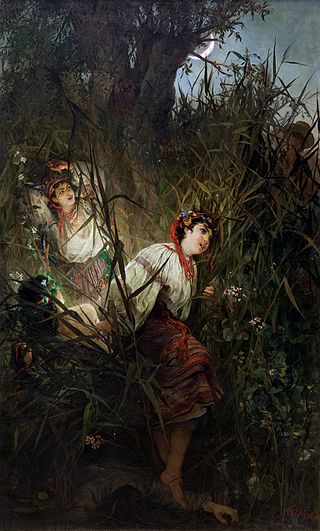
Other than the many gods and goddesses of the Slavs, the ancient Slavs believed in and revered many supernatural beings that existed in nature. These supernatural beings in Slavic religion come in various forms, and the same name of any single being can be spelled or transliterated differently according to language and transliteration system.

In the pre-Christian religion of Eastern and Southern Slavs, Rod is the god of the family, ancestors and fate, perhaps as the supreme god. Among Southern Slavs, he is also known as Sud. He is usually mentioned together with Rozhanitsy deities. One's first haircut (postriziny) was dedicated to him, in a celebration in which he and the rozhanitsy were given a meal and the cut hair. His cult lost its importance through time, and in the ninth or tenth century he was replaced by Perun, Svarog and/or Svetevid, which explains his absence in the pantheon of Vladimir the Great.
Iriy, Vyrai, Vyriy, or Irij is a mythical place in Slavic mythology where "birds fly for the winter and souls go after death" that is sometimes identified with paradise. Spring is believed to have arrived on Earth from Vyrai.

Radogost is, according to medieval chroniclers, the god of the Polabian Slavs, whose temple was located in Rethra. In modern scientific literature, however, the dominant view is that Radogost is a local nickname or a local alternative name of the solar god Svarozhits, who, according to earlier sources, was the chief god of Rethra. Some researchers also believe that the name of the town, where Svarozhits was the main deity, was mistakenly taken for a theonym. A popular local legend in the Czech Republic is related to Radogost.
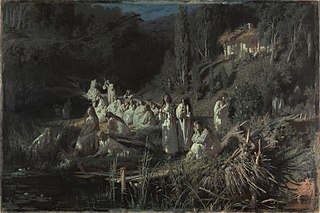
In Slavic folklore, the rusalka is a typically feminine entity, often malicious toward mankind and frequently associated with water, with counterparts in other parts of Europe, such as the French Melusine and the Germanic Nixie. Folklorists have proposed a variety of origins for the entity, including that they may originally stem from Slavic paganism, where they may have been seen as benevolent spirits. Rusalki appear in a variety of media in modern popular culture, particularly in Slavic language-speaking countries, where they frequently resemble the concept of the mermaid.

Green week, or the green holidays, is a traditional Slavic seasonal festival celebrated in early June. It is closely linked with the cult of the dead and the spring agricultural rites. In Eastern European villages, the seven weeks following Easter have historically been a time of festivity. Green week takes place during the seventh week leading up to the Pentecost, and includes the seventh Thursday after Easter, called Semik.

Kostroma is an East Slavic fertility goddess. Her name is derived from костёр (kostyor), the Russian word for "bonfire".
In historical Indo-European religion, the concept of an otherworld, also known as an otherside, is reconstructed in comparative mythology. Its name is a calque of orbis alius, a term used by Lucan in his description of the Celtic Otherworld.
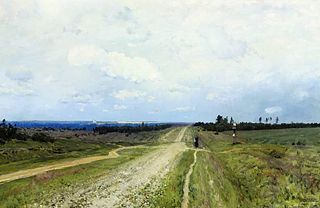
Nav is a phrase used to denote the souls of the dead in Slavic mythology. The singular form is also used as a name for an underworld, over which Veles exercises custody—it is often interpreted as another name for the underground variant of the Vyraj.
Rozhanitsy, narecnitsy, and sudzhenitsy are invisible spirits or deities of fate in the pre-Christian religion of the Slavs. They are related to pregnancy, motherhood, marriage and female ancestors, and are often referenced together with Rod. They are usually mentioned as three together, but sometimes up to 9 together, of whom one was a "queen" or singular. They are related to Dola, but it is not known on what terms. In Poland they were worshipped as zorze (auroras).

Niya is a Lechitic god of the underworld of unknown sex, whose exact functions are unknown. Niya is mentioned together with other gods worshipped by Poles, such as Yesha, Łada, or Devana. Niya's cult may be demonstrated by the sayings "Go to Niye" and "Dwell in Nya" collected by Polish ethnographer Aleksander Brückner. In recent years, the confidence in the authenticity of Niya has increased in the scientific community.
The Slavic creation myth is a cosmogonic myth in Slavic mythology that explains how the world was created, who created it, and what principles guide it. This myth, in its Christianized form, survived until the nineteenth and twentieth century in various parts of the Slavdom in chronicles or folklore. In the Slavic mythology there are three versions of this myth: the first version is the so-called earth-diver myth, which intertwines two main motifs: the dualistic motif – the cooperation of God and the Devil is required to create the world, and the oceanic motif – the pre-existence water, where the seed of the Earth comes from; the second version speaks about the origin of the universe and the world from the Cosmic Egg and the World Tree; the third one about creation from a dismemberment of a primordial being.
A płanetnik is a character from Slavic beliefs, a demonic or partly demonic creature which is an embodiment of atmospheric phenomena.






